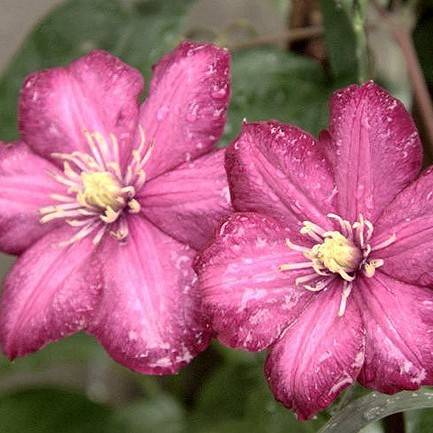
clematis
Clematis 'Ville de Lyon'
Cycle:
Perennial
Watering:
Average
Hardiness Zone:
4 - 9
Flowers:
Flowers
Sun:
Full sun,part shade
Leaf:
Yes
Growth Rate:
High
Maintenance:
Low
Care Level:
Medium
watering
Clematis 'Ville de Lyon' should be watered thoroughly, at least 1-2 times a week, depending on the weather/temperature and the soil status. When the soil feels dry to a 1-2 inch depth, it's time to water. Avoid splashing the foliage to prevent fungal diseases from developing. During warm summer months, water more often, as it may be necessary to water every day. In addition, make sure to keep the soil evenly moist but never wet. As a general rule, any clematis should be provided with 1-2 inches of water per week during the growing season.
sunlight
Clematis 'Ville de Lyon' is a climbing vine that prefers full sun to part shade. It requires at least 4 to 6 hours of direct sunlight each day during the spring and summer, and 2 to 4 hours during the fall and winter. In hotter climates, it should receive some shade in the afternoon to protect it from too much sun. Water this plant regularly, and provide supplemental support for the stems as it climbs.
pruning
Prune clematis 'Ville de Lyon' twice each year for best results and highest flowering potential. Prune once in late winter/early spring, cutting the main stems to just above the strongest, lowest buds. Prune a second time in mid-summer after flowering, trimming back any overly long stems to stimulate a second bloom. Pruning in summer also encourages a sturdy structure, protecting against wind damage.
Season
Hardiness Map
FAQ
Can Clematis plants grow in pots?
Yes, Clematis plants can definitely be grown in pots. When planting a Clematis in a pot make sure to use a larger size pot with drainage holes and fill it with a mix of well-draining potting soil and compost. Ensure to keep the root area cool and the pot in a sunny location while providing regular water and fertilization. Check the plant almost daily to make sure it is not becoming too dry. Clematis can do well in a pot and with the right care and conditions, they will thrive.
Are Clematis plants self-pollinating?
No, clematis plants are not self-pollinating. Clematis plants need pollinators such as bees, butterflies, moths and other insects to transfer pollen from the male anthers to the female stigma of the flower in order to produce viable seed. Pollination must also occur within relatively close proximity of the same species in order to create viable hybrid plants.
Can Clematis plants be grown as a houseplant?
Yes, Clematis plants can be grown as a houseplant. It is best to grow them in a pot with full sun and a soil that is rich in organic material and retains moisture. When potting the plant, place a stake or trellis next to the pot so that the vine can climb when it begins to grow. Be sure to water your Clematis plant regularly to keep it healthy and growing. Additionally, keep an eye out for pests and treat with natural insecticides as necessary.
Could Clematis plants survive in a colder climate?
Yes, Clematis plants can survive in colder climates with proper preparation. If planted in the fall, proper mulching should be done to protect the roots from cold temperatures. If planted in the spring, they should be watered frequently to help them adjust to the cooler temperatures more quickly. If temperatures drop below -20°C ( -4°F), additional measures may need to be taken such as the application of protective wraps and thermal insulation. Additionally, plants in exposed areas should be protected from the wind to prevent excessive dehydration. With the right measures in place, Clematis plants can easily survive in colder climates.
Could Clematis plants be grown in a greenhouse?
Yes, clematis plants can be grown in a greenhouse. Due to their vine-like growth habit and tropical native origins, clematis plants thrive in the moist and warm environment of a greenhouse. Clematis are generally grown from cuttings or from dividing existing plants, and benefit from regular pruning and fertilizing. They will also enjoy the indirect light of a greenhouse and the protection from strong winds and temperatures that the humidity and contained environment provides.
